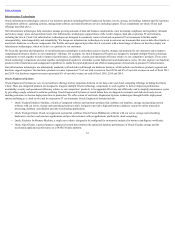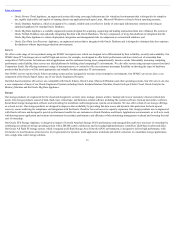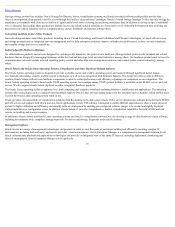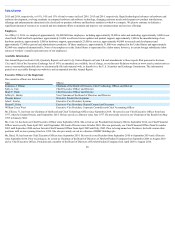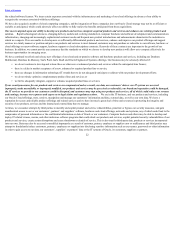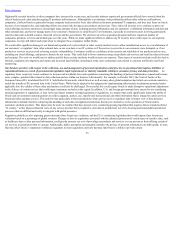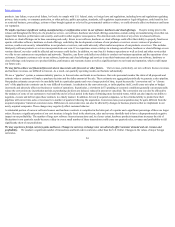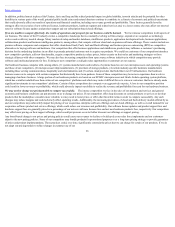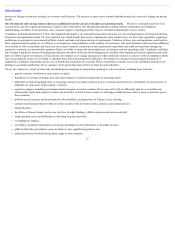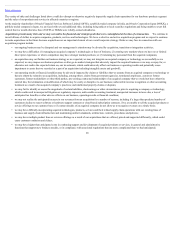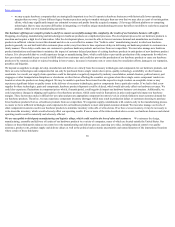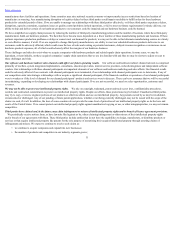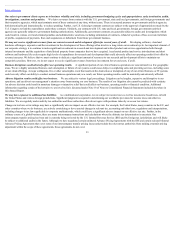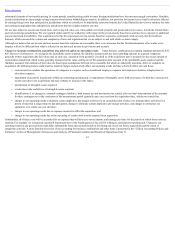Oracle 2015 Annual Report Download - page 26
Download and view the complete annual report
Please find page 26 of the 2015 Oracle annual report below. You can navigate through the pages in the report by either clicking on the pages listed below, or by using the keyword search tool below to find specific information within the annual report.
Table of Contents
products. Any failure, or perceived failure, by Oracle to comply with U.S. federal, state, or foreign laws and regulations, including laws and regulations regulating
privacy, data security, or consumer protection, or other policies, public perception, standards, self-regulatory requirements or legal obligations, could result in lost
or restricted business, proceedings, actions or fines brought against us or levied by governmental entities or others, or could adversely affect our business and harm
our reputation.
We might experience significant coding, manufacturing or configuration errors in our software, hardware and cloud offerings. Despite testing prior to the
release and throughout the lifecycle of a product or service, our software, hardware and cloud offerings sometimes contain coding or manufacturing errors that can
impact their function, performance and security, and result in other negative consequences. The detection and correction of any errors in released software,
hardware or cloud offerings can be time consuming and costly. Errors in our software, hardware or cloud offerings could affect their ability to properly function or
operate with other software, hardware or cloud offerings, could delay the development or release of new products or services or new versions of products or
services, could create security vulnerabilities in our products or services, and could adversely affect market acceptance of our products or services. This includes
third-party software products or services incorporated into our own. If we experience errors or delays in releasing our software, hardware or cloud offerings or new
versions thereof, our sales could be affected and revenues could decline. In addition, we run Oracle’s business operations as well as cloud and other services that
we offer to our customers on our products and networks. Therefore, any flaws could affect our ability to conduct our business operations and the operations of our
customers. Enterprise customers rely on our software, hardware and cloud offerings and services to run their businesses and errors in our software, hardware or
cloud offerings could expose us to product liability, performance and warranty claims as well as significant harm to our brand and reputation, which could impact
our future sales.
We may fail to achieve our financial forecasts due to inaccurate sales forecasts or other factors. Our revenues, particularly our new software licenses revenues
and hardware revenues, are difficult to forecast. As a result, our quarterly operating results can fluctuate substantially.
We use a “pipeline” system, a common industry practice, to forecast sales and trends in our business. Our sales personnel monitor the status of all proposals and
estimate when a customer will make a purchase decision and the dollar amount of the sale. These estimates are aggregated periodically to generate a sales pipeline.
Our pipeline estimates can prove to be unreliable both in a particular quarter and over a longer period of time, in part because the “conversion rate” or “closure
rate” of the pipeline into contracts can be very difficult to estimate. A reduction in the conversion rate, or in the pipeline itself, could cause us to plan or budget
incorrectly and adversely affect our business or results of operations. In particular, a slowdown in IT spending or economic conditions generally can unexpectedly
reduce the conversion rate in particular periods as purchasing decisions are delayed, reduced in amount or cancelled. The conversion rate can also be affected by
the tendency of some of our customers to wait until the end of a fiscal period in the hope of obtaining more favorable terms, which can also impede our ability to
negotiate, execute and deliver upon these contracts in a timely manner. In addition, for newly acquired companies, we have limited ability to predict how their
pipelines will convert into sales or revenues for a number of quarters following the acquisition. Conversion rates post-acquisition may be quite different from the
acquired companies’ historical conversion rates. Differences in conversion rates can also be affected by changes in business practices that we implement in our
newly acquired companies. These changes may negatively affect customer behavior.
A substantial portion of our new software licenses and hardware contracts is completed in the latter part of a quarter and a significant percentage of these are larger
orders. Because a significant portion of our cost structure is largely fixed in the short term, sales and revenue shortfalls tend to have a disproportionately negative
impact on our profitability. The number of large new software licenses transactions and, to a lesser extent, hardware products transactions increases the risk of
fluctuations in our quarterly results because a delay in even a small number of these transactions could cause our quarterly sales, revenues and profitability to fall
significantly short of our predictions.
We may experience foreign currency gains and losses. Changes in currency exchange rates can adversely affect customer demand and our revenue and
profitability. We conduct a significant number of transactions and hold cash in currencies other than the U.S. Dollar. Changes in the values of major foreign
currencies,
24


